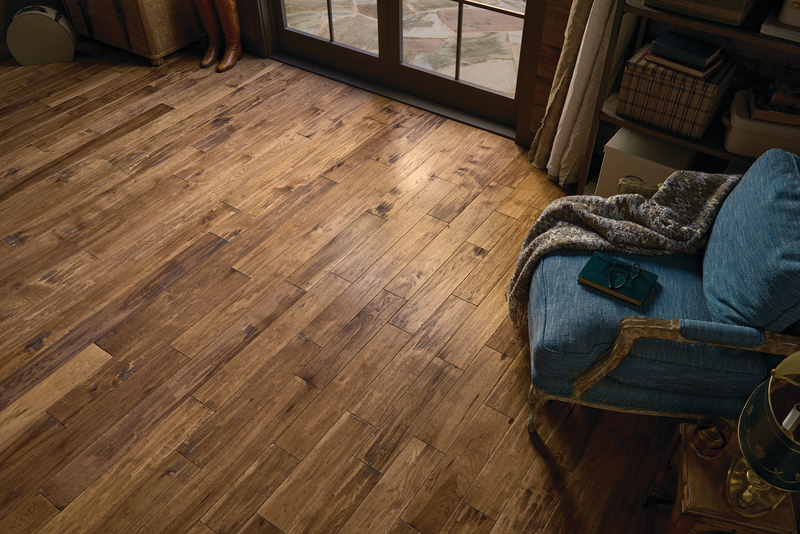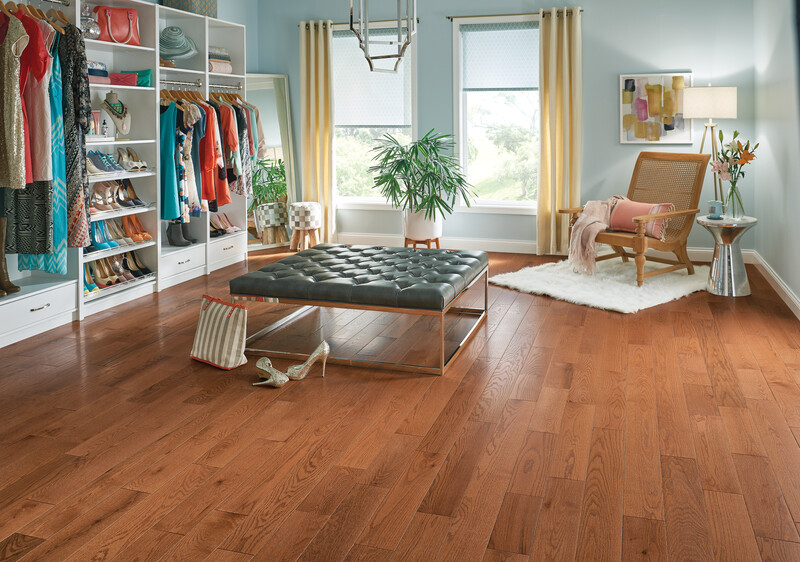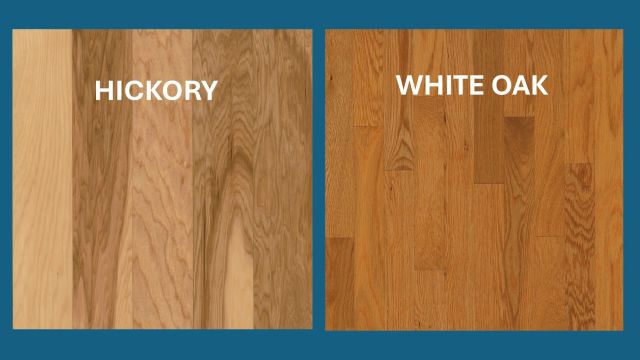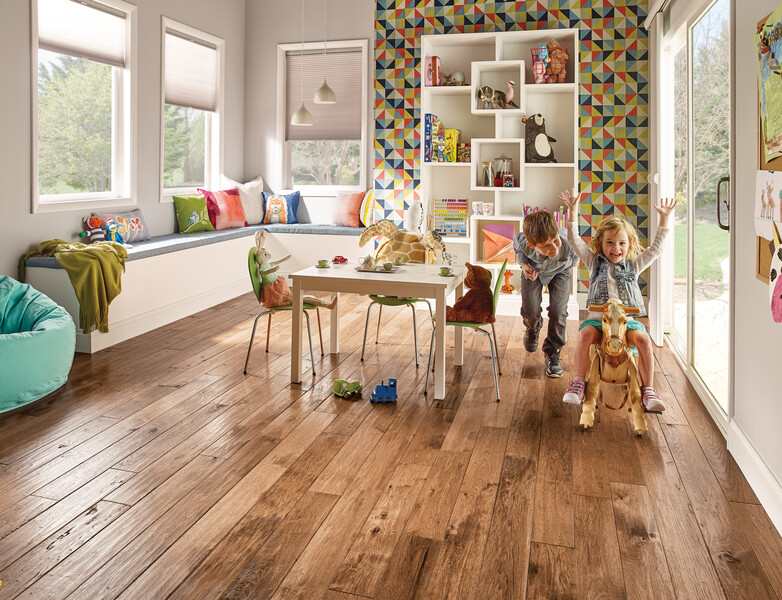Hickory vs. Oak Flooring – A Comprehensive Guide
May 9, 2025
Two species often strike a chord with American homeowners with hardwood flooring: hickory and oak. These domestic hardwoods are popular for their beauty, durability, and wide availability. But which is the better selection?
You’re not alone if you are torn between hickory wood floors and oak. Once you understand the differences, you’ll be better positioned to decide.
In this guide, we break down the key factors—color, grain, strength, price, and more—to help you make the right decision for your home.

Hickory Wood Floors vs Oak – Pros and Cons
Before discussing the details of where each flooring option shines, let’s review the pros and cons of each.
Here’s a quick breakdown to help compare:
| Feature | Hickory | Oak |
| Color Variation | High variation, dramatic tones | More uniform, subtle tones |
| Grain Pattern | Complex grains, bold look | Straight grain, more classic appearance |
| Hardness (Janka Scale) | 1820 (very hard) | White Oak: 1360, Red Oak: 1290 |
| Dent/Scratch Resistance | High resistance | Moderate resistance |
| Cost | Slightly higher | Generally lower |
| Style Fit | Rustic, bold, modern-rustic | Traditional, transitional, modern |
| Best For | High traffic areas, active homes | Versatile for most settings |
With that in place, now let’s provide a clearer notion of the characteristics of these two popular wood species.

Hickory Flooring vs Oak for Color
Color is often the first thing people notice when shopping for hardwood. And guess what? Hickory and oak tell two different stories with their color variations.
Each species brings its personality to the table. Differences in tones, shades, and natural variation can dramatically influence a room’s feel.
Hickory Color Tones
Hickory flooring often features bold color contrasts, ranging from light creams to deep browns in the same board. These natural variations give it a rustic, high-character look. It works well in farmhouse or cabin-style interiors, or anywhere you want a bit more visual drama.
Oak Colorations
Oak flooring, predominantly white and red oak, has a more uniform appearance. White oak flooring tends to lean cooler with hints of beige and slight gray. Red oak flooring brings warm reddish-brown tones. Oak might be your pick if you prefer a more consistent, traditional look.
Hickory vs Oak Flooring for Grain Patterns
Grain pattern is more than just a visual detail—it defines the texture, movement, and overall feel of your hardwood flooring. Whether you want something subtle and refined or bold and attention-grabbing, the grain tells the story.
Grain patterns are where you’ll see some of the most noticeable stylistic differences between oak and hickory.
Hickory features dramatic, complex grains with sharp contrasts. It has tons of personality, and if you like a floor with movement and variation, it brings that in spades.
Oak offers a more traditional look. White oak has long, straight grain lines that look smooth and clean. Red oak has a more pronounced grain but still feels orderly compared to hickory.
Your choice here comes down to visual preference. Hickory makes a bold statement, while oak keeps things classic.

Hickory vs Oak Strength
Strength matters, especially in high-traffic areas like living rooms, kitchens, or hallways. And it just so happens there’s a rating to help determine wood’s strength.
The Janka hardness scale is the industry standard for comparing wood hardness. It measures the force required to embed a 7/16-inch steel ball halfway into a wood sample.
And the winner for hickory and oak hardwood?
Hickory scores a solid 1820 on the Janka hardness rating, making it one of the hardest domestic hardwoods available. The wood is highly resistant to dents and scratches, ideal for homes with kids, pets, or heavy foot traffic.
White oak is 1360, and red oak is 1290. While not as hard as hickory, both types of oak still perform well and offer a durable surface for everyday use.
So, is oak harder than hickory, as many assume? No—hickory wins in sheer hardness, hands down.
How Do Hickory and Oak Floors Hold Up Over Time?
Investing in hardwood floors is not just about looks—it’s about how the floor will perform for years to come.
- Hickory is one of the most scratch-resistant domestic hardwoods, thanks to its high 1820 Janka score. Hickory is tough to beat if you have pets, kids, or lots of foot traffic. Its density means it takes longer to show wear, making it an excellent choice for longevity in active households.
- Oak, both red and white, also offers strong long-term performance. While it’s not as hard as hickory, it ages gracefully and maintains well. White oak, in particular, is slightly more moisture-resistant than red oak. That makes it a solid option for kitchens or entryways.
Depending on thickness, finish, and care, both species can last 30 to 100 years. Remember, you can sand and refinish solid hardwoods to extend their life for decades.
Not surprisingly, some manufacturers like Hartco® offer a lifetime residential warranty on their American Scrape™ hardwood flooring. The collection of hand-scraped flooring includes hickory, oak, and maple options.
The Cost of Oak vs. Hickory Hardwood Floors
Hickory hardwood floors tend to be slightly more expensive than oak hardwood floors. Supply is one reason, as oak is more abundant in U.S. forests. However, its availability keeps its price lower.
Another reason is hickory’s hardness and distinctive grain patterns. It offers a more unique flooring option than oak.
The cost range for both species can vary depending on grade, finish, and installation method. Here’s a side-by-side look at the latest pricing estimates:
| Flooring Type | Material Cost (per sq. ft.) | Installed Cost (per sq. ft.) |
| Hickory | $6 – $10 | $10 – $17 |
| White Oak | $5 – $7 | $12.77 – $16.19 |
| Red Oak | $6 – $8 | Similar to White Oak |
(Source: GoFlooring)
Oak is generally more affordable and easier to install. However, many homeowners find the added durability and dramatic grain of hickory worth the slightly higher cost.

Hickory vs Oak Flooring—Which Is Right for You?
When comparing oak vs hickory hardwood floors, the right choice depends on your priorities:
- Go with hickory if you need ultra-durability, love bold, rustic looks, or have a high-traffic household.
- Choose oak for a versatile, classic wood flooring option with easier matching and a slightly lower price point.
Both options are winners, and whether you lean modern, traditional, or somewhere in between, there’s a hardwood floor that fits your style.
Whichever you decide, count on Hartco for real hardwood floors that stand the test of time. You can select from solid and engineered hardwood in various colors and finishes to suit your style. Find a Hartco dealer near you for the perfect hickory and oak flooring selections.
